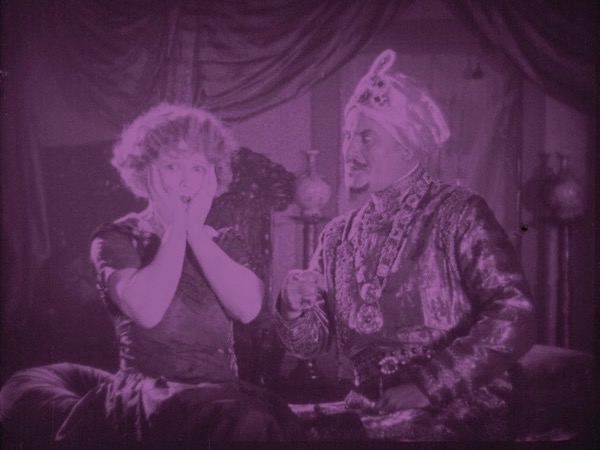3 DAYS TO LIVE (Three Days to Live)
Tom Gibson (US 1924)
3 Days to Live (1924), recently restored from an incomplete tinted nitrate print by Australia’s National Film and Sound Archive, was written and directed by Tom Gibson and starred Ora Carew. However, it’s most interesting to film historians because a young Frank Capra is credited with the editing and the titles. Produced by the Gerson Pictures Corp. of San Francisco (Capra’s then father-in-law, William Howell, was a principal investor), the film was shot in 1923, and, according to the trade magazine Camera, released in the United States in late January 1924.
The film traces how two affluent San Francisco stock investors, James Harmon and “Wolf” Raymond, are being attacked by an “Unknown Power” who “has hurled the stock market into a frenzy” and threatened to ruin the fortunes of the two men. Their two children – Grace Harmon and Bob Raymond – provide the love interest in the film and subsequently seek to protect Grace’s father after he begins receiving threatening pieces of paper with tiger heads and a number indicating how many days the recipient has left to live. We eventually learn that the “Unknown Power” is a wealthy Rajah who is determined to make the two fathers pay, with their money and their lives, for having humiliated him in the presence of his servants when the two men were travelling in the Far East. Although the final reel of the film is missing, a title card based on contemporary reviews summarizes the likely ending: after subduing the Rajah’s two servants, Hakim and Hadi (the latter played by Capra’s first wife, Helen Howell), Bob Raymond races to the Rajah’s isolated house, subdues the Rajah, and frees Grace. Her father is saved and the couple united.
Although it is difficult to pinpoint Capra’s contributions to this film, we do know that the San Francisco-based Gerson Pictures Corporation made four feature films between 1922 and 1924 – 3 Days to Live was the third – and that Capra biographer Joseph McBride indicates that Capra was also assistant director on all four. Although Tom Gibson was the writer and director, we may perceive something of Capra’s touch in the rhetoric of the titles and the modes of editing. Note, for example, the three consecutive titles when the Rajah and his two servants are first introduced: “The ‘Rajah,’ an evil Spirit out of the East – consumed by a ruthless hate”; “Hadi, the slave, bound by shackles of fear to her sinister master”; and “Hakim, the instrument of his master’s vengeance.” The Rajah character points back to DeMille’s The Cheat (1915) – and the many cinematic Asian villains whom that film spawned – but also looks forward to Capra’s The Bitter Tea of General Yen (1933). More to the point, the titles suggest Capra’s later ability to depict powerful and dynamic villains, surrounded by their sycophantic henchmen, like Jim Taylor in Mr. Smith Goes to Washington (1939).
Capra’s editing is not as accomplished as it would become in his great period between American Madness in 1932 and It’s a Wonderful Life in 1946: when Capra became a director and orchestrated camera framing, lighting, sound, and editing, he was capable of moving audiences from deep despair to elation, as in the Pottersville sequence and the final scene of the latter film. However, there are hints of what was to come in Capra’s career. Scenes make precise use of what had already become conventions of Hollywood continuity editing: often starting scenes with establishing shots and then breaking the space down into tighter framings; skillfully cutting on action, as when James Harmon walks from his entry to his office; and using the eyeline match, as when Wolf Raymond looks down toward his desk and Capra cuts to a warning with two tiger heads. Sometimes the editing harks back to Griffith (an acknowledged Capra influence), especially in the irises that often begin and end scenes, and occasionally when the iris is used in a tighter framing to direct the audience’s attention to the middle of the screen. Another unusual device comes when Capra – to emphasize how Hadi has fallen in love with Bob – dissolves from a medium shot of Hadi in profile to a close-up subjective shot of her drawing a picture of Bob toward her, then another dissolve to the original medium shot. The seeds of Capra’s later powerful and effective editing seem apparent here.
Since 3 Days to Live was shot in San Francisco, viewers may be able to recognize landmarks that trade journals referred to, like the Palace of Fine Arts, and what was then the newly completed Skyline Boulevard. The trade press suggests that although the film did get fairly broad distribution, the reviews weren’t great. Variety judged that although the film was stronger than the previous Gerson film, it was still “many miles from being even a fair picture,” lamenting that Ora Carew was being wasted in “mediocre vehicles.” Nevertheless, to silent film cineastes, the beautiful tinting and restoration, as well as Capra’s contributions to the film, make 3 Days to Live a worthwhile viewing experience.
Charles Maland

regia/dir, scen: Tom Gibson.
mont/ed, didascalie/titles: Frank Capra.
photog: George Crocker.
cast: Ora Carew (Grace Harmon), Jay Morley (Bob Raymond), Dick La Reno (Wolf Raymond), Hal Stephens (Rajah), James Lono (Hakim), Helen Howell (Hadi), George Webster (James Harmon).
prod: Paul Gerson, Gerson Pictures Corporation.
riprese/filmed: 1923, San Francisco.
uscita/rel: 01.1924.
copia/copy: incomp. (ultimo rullo mancante/final reel missing), 35mm, 3349 ft., 49′ (18 fps), col. (imbibito/tinted); did./titles: ENG.
fonte/source: National Film and Sound Archive, Canberra.
Restauro/Restored: 2016 (lab. Haghefilm Digitaal, Amsterdam).


 Italiano
Italiano